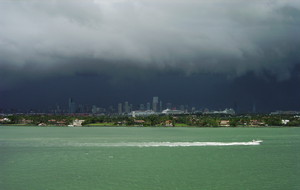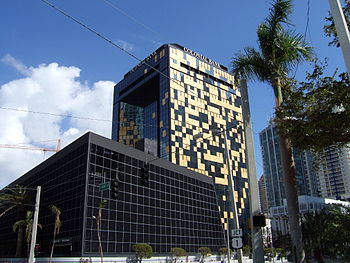- Climate of Miami
-
 Typical summer afternoon shower rolling in from the Everglades.
Typical summer afternoon shower rolling in from the Everglades.
Miami Climate chart (explanation) J F M A M J J A S O N D 275592.177602.479642.982686.285729.388755.789767.689777.688765.685722.780671.87762Average max. and min. temperatures in °F Precipitation totals in inches Source: WMO Metric conversion J F M A M J J A S O N D 512415532516612618722820158302223731241453225193322519431241432922682719462516Average max. and min. temperatures in °C Precipitation totals in mm Miami has a tropical monsoon climate (Köppen climate classification Am)[1] with hot and humid summers and short, warm winters, with a marked drier season in the winter. Its sea-level elevation, coastal location, position just above the Tropic of Cancer, and proximity to the Gulf Stream shape its climate. With January averaging 75.2 °F (24.0 °C), winter features mild to warm temperatures; cool air usually settles after the passage of a cold front, which produces much of the little amount of rainfall. Lows sometimes fall below 50 °F (10 °C), but very rarely below 35 °F (2 °C). Highs generally range between 70–77 °F (21–25 °C). The wet season begins some time in May, ending in mid-October. During this period, temperatures are in the mid 80s to low 90s (29–35 °C), accompanied by high humidity, though the heat is often relieved by afternoon thunderstorms or a sea breeze that develops off the Atlantic Ocean, which then allow lower temperatures, but conditions still remain very muggy. Much of the year's 55.9 inches (1,420 mm) of rainfall occurs during this period.
In addition to its sea-level elevation, coastal location and position just above the Tropic of Cancer, the area owes its warm, humid climate to the Gulf Stream, which moderates climate year-round. A typical summer day does not have temperatures below 75 °F (24 °C). Temperatures in the high 80s to low 90s (30-35 °C) accompanied by high humidity are often relieved by afternoon thunderstorms or a sea breeze that develops off the Atlantic Ocean, which then allow lower temperatures, although conditions still remain very muggy. During winter, humidity is significantly lower, allowing for cooler weather to develop. Average minimum temperatures during that time are around 60 °F (15 °C), rarely dipping below 35 °F (2 °C), and the equivalent maxima usually range between 70 and 77 °F (19-24 °C).
Miami has recorded a triple-digit temperature only once; the highest temperature recorded was 100 °F (38 °C), on July 21, 1942.[2] The coldest temperature ever recorded in the city of Miami was 27 °F (-1 °C) on February 3, 1917. Miami has never recorded an accumulation of snow, and only once recorded flurries, on January 19, 1977. Weather conditions for the area around Miami were recorded sporadically from 1839 until 1900, with many years-long gaps. A cooperative temperature and rainfall recording site was established in what is now Downtown in December, 1900. An official Weather Bureau Office was opened in Miami in June, 1911.[3]
Miami receives abundant rainfall, one of the highest among major U.S. cities. Most of this rainfall occurs from mid-May through early October. It receives annual rainfall of 58.6 inches (1488 mm),[4] whereas nearby Fort Lauderdale and Miami Beach receive 63.8 in (1621 mm) and 48.3 in (1227 mm), respectively, which demonstrates the high local variability in rainfall rates.
Hurricanes
 Damage to office building 1200 Brickell after Hurricane Wilma in Downtown Miami.
Damage to office building 1200 Brickell after Hurricane Wilma in Downtown Miami.
The Atlantic Hurricane season officially runs from June 1 through November 30, although hurricanes can develop beyond those dates. The most likely time for Miami to be hit is during the peak of the Cape Verde season which is mid-August through the end of September.[5] Due to its location between two major bodies of water known for tropical activity, Miami is also statistically the most likely major city in the world to be struck by a hurricane, trailed closely by Nassau, Bahamas, and Havana, Cuba. Despite this, the city has been fortunate in not having a direct hit by a hurricane since Hurricane Cleo in 1964.[6] However, many other hurricanes have affected the city, namely the Great Miami Hurricane in 1926, Betsy in 1965, Andrew in 1992, Irene in 1999, and Hurricanes Katrina and Wilma in 2005. At least 35 direct and 26 indirect deaths in Florida were attributed to Wilma.
In addition, a tropical depression in October 2000 passed over the city, causing record rainfall and flooding. Locally, the storm is credited as the No Name Storm of 2000, though the depression went on to become Tropical Storm Leslie upon entering the Atlantic Ocean.
Hurricane , known as the "Great Miami Hurricane of 1926," caused catastrophic damage to the then relatively new Miami and Miami Beach area. Hurricane Betsy passed over Key Largo, south of the city, but did cause hurricane force winds and very heavy rainfall there. Hurricane Andrew in 1992 also struck south of city and caused extensive damage and flooding in the Homestead area suburbs. Hurricane Wilma in 2005 caused severe damage to many high-rise buildings in the downtown area as it broke many windows out, which in turn caused bad water damage on the insides of the buildings. It also caused at least 35 direct and 26 indirect fatalities in Florida.
Miami has been identified as one of three cities in the United States most vulnerable to hurricanes, mainly due to its location and it being surrounded by ocean and low-lying coastal plains, the other two cities being New Orleans and New York City.[7]


Typical winter day in Miami Climate data for Miami (MIA) Month Jan Feb Mar Apr May Jun Jul Aug Sep Oct Nov Dec Year Average high °F (°C) 75.2
(24.0)76.5
(24.7)79.2
(26.2)82.4
(28.0)85.3
(29.6)87.6
(30.9)89.1
(31.7)89.1
(31.7)87.8
(31.0)84.6
(29.2)80.4
(26.9)76.6
(24.8)82.8 Daily mean °F (°C) 67.2
(19.6)68.5
(20.3)71.7
(22.1)75.1
(23.9)78.7
(25.9)81.3
(27.4)82.7
(28.2)82.9
(28.3)81.9
(27.7)78.4
(25.8)73.6
(23.1)69.1
(20.6)75.9 Average low °F (°C) 59.2
(15.1)60.4
(15.8)64.2
(17.9)67.8
(19.9)72.1
(22.3)75.0
(23.9)76.3
(24.6)76.6
(24.8)75.9
(24.4)72.1
(22.3)66.7
(19.3)61.5
(16.4)69.0 Rainfall inches (mm) 2.012
(51.1)2.079
(52.8)2.39
(60.7)2.85
(72.4)6.209
(157.7)9.331
(237.0)5.701
(144.8)7.579
(192.5)7.63
(193.8)5.642
(143.3)2.661
(67.6)1.831
(46.5)55.913
(1,420.2)Avg. rainy days (≥ 1.0 mm) 5.3 4.6 4.9 4.5 9.0 13.8 13.3 15.0 14.2 10.9 7.1 4.5 107.1 Sunshine hours 220.1 217.5 275.9 294.0 300.7 288.0 310.0 288.3 261.0 260.4 222.0 217.0 3,154.9 Source no. 1: World Meteorological Organization (UN)[8] Source no. 2: Hong Kong Observatory (sunshine hours) [9] This chart shows the average coastal ocean water temperature by month in degrees Fahrenheit for Miami Beach based on historical measurements.[10]
January February March April 1-15 April 16-30 May 1-15 May 16-31 June 1-15 June 16-30 July 1-15 July 16-31 August 1-15 August 16-31 September 1-15 September 16-30 October 1-15 October 16-31 November December 75 73 75 78 78 80 81 84 85 86 86 86 84 84 83 83 79 76 75 References
- ^ "World Map of Köppen−Geiger Climate Classification". http://koeppen-geiger.vu-wien.ac.at/pdf/kottek_et_al_2006_A1.pdf.
- ^ "Fort Lauderdale-Hollywood International Airport Equals All Time High Temperature Record June 22; Daily Records Fall at Miami and West Palm Beach". National Oceanic and Atmospheric Administration. http://www.srh.noaa.gov/images/rtimages/mfl/news/statement2.pdf. Retrieved June 09, 2011.
- ^ "History of National Weather Service Forecast Office-Miami, Florida". National Oceanic and Atmospheric Administration. http://www.srh.noaa.gov/mfl/history/. Retrieved 2007-08-19.
- ^ "NWS Miami Normals and Records Page". National Weather Service. http://www.srh.noaa.gov/mfl/localdata.php. Retrieved 2007-08-19.
- ^ "Vulnerable cities: Miami, Florida". The Weather Channel. Archived from the original on 2006-04-27. http://web.archive.org/web/20060427194724/http://www.weather.com/newscenter/specialreports/hurricanes/vulnerablecities/miami.html. Retrieved 2006-02-19.
- ^ "Miami, Florida's history with tropical systems". Hurricane City. http://www.hurricanecity.com/city/miami.htm. Retrieved 2006-02-19.
- ^ Tidwell, Mike (2006). The Ravaging Tide: Strange Weather, Future Katrinas, and the Coming Death of America's Coastal Cities. Free Press. ISBN 0-7432-9470-X.
- ^ "Weather Information for Miami, Florida". http://www.worldweather.org/093/c00267f.htm#wxforecast. Retrieved 2010-05-06.
- ^ "Climatological Normals of Miami". Hong Kong Observatory. http://www.hko.gov.hk/wxinfo/climat/world/eng/n_america/us/miami_e.htm. Retrieved 2010-05-06.
- ^ Charles Sun. "US NODC Coastal Water Temperature Guide". Nodc.noaa.gov. http://www.nodc.noaa.gov/dsdt/wtg12.html. Retrieved 2011-06-09.
City of Miami Accent • Arts • Climate • Companies • Downtown • Education • Fire • Government • Historic Landmarks • History • Library • Mayors • Miamians • Music • Neighborhoods • Police • Skyscrapers • Sports • Television • Transportation Categories:
Categories:- Climate by city
- Climate of Florida
Wikimedia Foundation. 2010.
